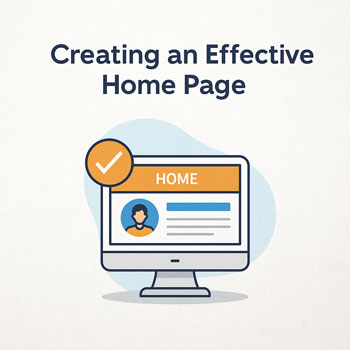
Creating an Effective Home Page
Learn how to design a high-converting homepage that clearly communicates your value, guides visitors through your content, and encourages them to take action. This lesson covers structure, messaging, layout, and essential elements every homepage should include.
Learning Objectives
- Understand the purpose of a homepage and what visitors expect.
- Learn the essential sections of a modern, effective homepage.
- Write messaging that is clear, concise, and benefit-driven.
- Design a homepage layout that supports user flow and conversions.
- Use CTAs (calls-to-action) strategically throughout the page.
The Purpose of a Homepage
Your homepage is your digital first impression. It must immediately answer the visitor’s most important questions:
- What do you do?
- Who is this for?
- Why should they trust you?
- What should they do next?
If your homepage fails to answer these questions quickly, visitors will leave.
Essential Sections of an Effective Home Page
1. Hero Section (Headline + Subheadline + CTA)
- Clear headline explaining what you do.
- Supporting subheadline focusing on benefits.
- Primary call-to-action (CTA) such as “Get a Quote” or “Book a Call”.
- Optional secondary CTA like “Learn More”.
2. Introduction or Value Proposition
Brief paragraph explaining what makes your business unique.
3. Services or Offerings Overview
- List your primary services.
- Add short descriptions and icons/images.
- Include a CTA linking to full service pages.
4. Social Proof (Testimonials / Reviews)
- Show real customer reviews.
- Logos of companies you’ve worked with.
- Ratings from Google, Facebook, or Yelp.
5. About / Why Choose You
- Introduce yourself or your company.
- Explain why customers can trust you.
- Share mission, values, or certifications.
6. Portfolio or Featured Work (If Relevant)
- Show examples of past work.
- Use images, videos, or short case studies.
7. CTA Section
Repeat your primary CTA with a bold, visually clear section.
8. FAQ Section
Answer common questions to remove buying barriers.
9. Footer
- Navigation links
- Contact details
- Social icons
- Legal links (Privacy Policy, Terms)
Writing Messaging for Your Homepage
Headline Formula
What you do + Who you help + Outcome they want.
Examples
- “Professional Landscaping for Homeowners Who Want a Beautiful, Low-Maintenance Yard.”
- “Modern Websites for Small Businesses That Want More Leads.”
- “Reliable Electrical Services for Families and Local Businesses.”
Subheadline Formula
Explain how your service helps in one short, benefit-focused sentence.
Examples
- “We design fast, mobile-friendly websites that convert visitors into customers.”
- “Get same-day repair from licensed electricians you can trust.”
Designing a Smooth User Flow
Your homepage should guide visitors step-by-step toward your main conversion goal.
Recommended Flow
- Attention-grabbing hero message.
- Quick explanation of what you do.
- List of services or offerings.
- Proof that you are trustworthy.
- Reason why they should choose you.
- Final CTA encouraging them to act.
Homepage Design Tips
- Use plenty of white space for clarity.
- Keep text short and easy to scan.
- Use visuals that support your message (not generic stock photos).
- Make CTAs highly visible with strong color contrast.
- Test your homepage on mobile—most visitors browse on phones.
Common Homepage Mistakes to Avoid
- Using vague or confusing headlines.
- Burying the most important information below the fold.
- Using too many CTAs that cause decision fatigue.
- Cluttered or overwhelming design.
- Writing long paragraphs instead of scannable sections.
- Using technical language your audience doesn’t understand.
Activity: Outline Your Homepage
Create a simple outline for your homepage using the steps below:
- Write your homepage headline.
- Write your subheadline.
- List your top 3 services or offerings.
- Write 2–3 bullet points explaining why customers should choose you.
- Choose your primary CTA.
- Plan which testimonials to include.
- Plan your final CTA section.
Deliverable: Submit your homepage outline and hero section messaging.
